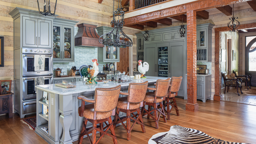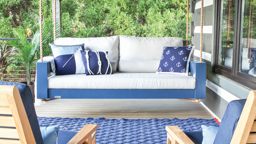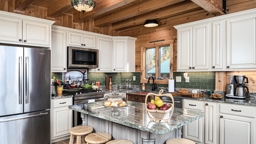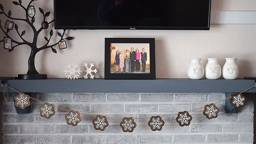In order to get the log or timber home of your dreams, you sometimes need a healthy dose of reality. These cost-cutting tips can help eliminate unnecessary spending from your budget while still maintaining the vision of your dream home.
General Design
1. Start with a Stock Plan.
Instead of a custom design, opt for a stock plan from your log or timber home provider’s catalog. Stock designs have been built many times before, so construction errors have been eliminated.
If tweaks are needed, Richard Titorenko, a 14-year industry home veteran with Coventry Log Homes, suggests you work with a draftsman, rather than hiring an architect. “A company’s design staff is fully equipped and prepared to customize a plan to suit your needs,” he says. And a certain number of changes are often built into the price.
2. Design a Rectangular Plan.
Whether stock or custom, a rectangular design is the most economical shape to build. If you’re afraid it will be boring, fear not! Designers have myriad tricks up their sleeves to create visual interest without venturing “outside the box.”
3. Opt for Open Concept.
You can keep square footage small and increase your usable living space with an open floor plan that removes unnecessary hallways. Also look for innovative ways to use traditionally wasted space, like under-stair storage, and built-ins that eliminate the need for bulky furniture (another extra expense).
4. Build Up, Not Out.
With square footage being equal, it’s almost always less expensive to build a multi-story home than to spread it out over one level. If you’re looking to save even more, adding a dormer within the roof or attic will let you create a loft living area, which is far less expensive than a complete second story.
5. Choose a Pre-Cut Package.
If a log home is what you’re after, a package that’s completely pre-cut in a manufacturer’s mill will typically cost less than logs that have to be cut and fitted on site. The cost of the package itself will be a little more than site-cut, but the amount you save in labor costs should more than make up for it.
Construction & Labor Savings
6. Clear Your Own Site.
As much as 35 percent of your budget will go to clearing your home site, excavating a foundation, creating a driveway and installing utilities. But you can earn a little sweat equity by clearing trees and foraging for found materials (like rocks and wood) for later use.
7. Add Living Space Down Below.
A full basement with roughed-in plumbing and electrical lines is one of the most affordable ways to add extra living space to your log home, according to Rick Kinsman, owner of 1867 Confederation Log Homes in Ontario, Canada.
8. Incorporate Stacked Baths.
Putting two bathrooms back to back — or stacked above and below in a two-story design — will reduce the length of pipe you will need to run (and, thus, your contractor’s workload), saving you money.
Exterior Design
9. Add Outdoor Living Space.
Part of the log and timber home lifestyle is spending time outside, and adding porches, patios and decks can give your overall living space a big boost at a fraction of the cost of increasing your interior square footage. But be cautious — wraparound porches can still run you upwards of $25,000 for 150 feet of porch. To cut costs even further, look to a smaller covered porch at the front door.
10. Look to Landscaping.
“A thoughtful landscaping plan can make your home look like a million bucks, even when it isn’t,” says Richard. With a little research and muscle, this is a project even the most tentative DIYer can handle. Just be sure to keep shrubs and plants at least 2 to 3 feet away from your walls. Otherwise you might trap moisture against the home and add time (and cost) to your maintenance routine.
11. Build Walkways with Cheaper Alternative Materials.
Crushed stone, flagstone or concrete pavers (stones that are usually placed on top of sand) make attractive and affordable alternatives to poured concrete for walkways, patios, pool decks and more.
Roof & Ceiling
12. Keep Your Roofline Simple.
A single ridgeline instead of hips, valleys and multiple roof planes will shave costs off the roof. Extreme angles, such as turrets or an angled prow under an A-frame, cost more in materials and labor.
13. Keep a Low (Ceiling) Profile.
If you worship cathedral ceilings, use them in the great room — but keep the ceilings in other rooms lower (in the 8-foot realm). A change in ceiling height also helps visually define spaces within an open floor plan.
14. Consider Solar Tube.
If you can afford dramatic skylights, go for it, but don’t discount solar tubes. “Not only do they bring in natural light and cut down on installation and materials costs, they are directional, so you can channel the light exactly where you want it to go,” explains Tennessee log home builder Dan Mitchell.
15. Keep it Simple.
Don’t get fancy with your woodwork. Let the natural look of standard logs or king post timber trusses speak for themselves … because they will. Don’t worry about intricate designs or over-the-top treatments. Wood homes make a statement all on their own.
Floor Tips
16. Use Dimensional Lumber in Floors.
Squeak-free, engineered trusses like I-joists can span long distances (great for open floor plans) and are easy to install. Dimensional lumber is more affordable and hardier in the event of a plumbing accident.
17. Lay Laminate or Vinyl Flooring.
The most economical flooring is carpet and pad, which can be a comfortable option for the bedroom or basement. But today’s log and timber-frame home buyer isn’t typically a wall-to-wall carpet fan. Laminate and even vinyl flooring (like luxury vinyl plank or “LVP”) have vastly improved in their offerings and quality over the past few years, and thus, have increased in popularity. As with many materials, you have to be a smart comparison shopper, but laminates and vinyl will usually save you money over authentic hardwood flooring.
18. Be Consistent with Flooring Materials.
To reduce flooring costs, pick one product and use it in as much of the home as possible. Switching gears between laying wood in the great room and then tile in the kitchen will cost you both in terms of time and money. Plus, if your house is on the small side, one consistent flooring material will make it look more expansive.
Finishing Touches
19. Consider Fiberglass Doors.
A pre-hung steel unit will work well and is easy to install. For more dent protection, upgrade to fiberglass, which offers a wood-like texture with less maintenance. Whether you go with fiberglass or wood, pre-hung doors are always less expensive, and far less labor, than door jambs framed on site.
20. Start with Low-Cost Lighting Fixtures and Upgrade Later.
Specify low-cost lighting fixtures and upgrade them in the future. Try inexpensive LED lights above and below cabinetry as task lighting for cooking. Bonus: They are much more energy efficient than their fluorescent counterparts — continuing to save you money for years to come.
21. Opt for a Factory-Made Hearth.
Instead of a traditional masonry fireplace (which can cost upwards of $50k) choose a factory-made, direct-vent, zero-clearance fireplace, which can be accented with decorative rock.
22. Don’t Shy Away from Granite or Quartz.
To save money on your kitchen’s work surfaces, many buyers assume laminate is the only option. Not so, says Richard. “If you shop smart, there are deals to be had.” For his own home, Richard found that he could get granite counters for only $1,500 more than laminate. “In terms of beauty and durability, going with granite was a no-brainer. My color choices were limited with the bargain granite, but they were all beautiful.”
23. Incorporate a Simple, Straight Stair Design.
A simple, straight-stair design can save you considerable cash. For the ultimate budget buy, opt for a plain set of stairs (for a few hundred bucks) concealed under pad and carpet, rather than the popular but pricier half-log tread option.














